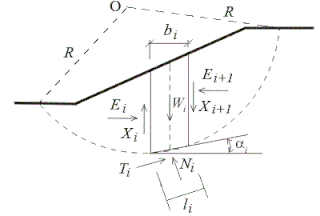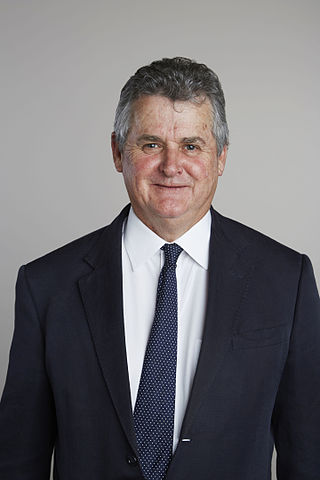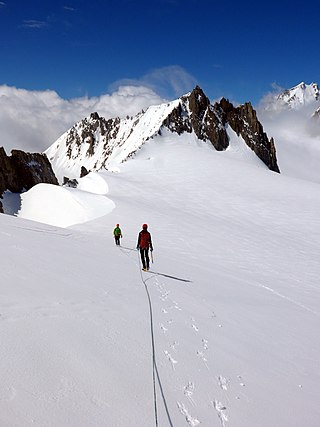Related Research Articles
A discrete element method (DEM), also called a distinct element method, is any of a family of numerical methods for computing the motion and effect of a large number of small particles. Though DEM is very closely related to molecular dynamics, the method is generally distinguished by its inclusion of rotational degrees-of-freedom as well as stateful contact and often complicated geometries. With advances in computing power and numerical algorithms for nearest neighbor sorting, it has become possible to numerically simulate millions of particles on a single processor. Today DEM is becoming widely accepted as an effective method of addressing engineering problems in granular and discontinuous materials, especially in granular flows, powder mechanics, and rock mechanics. DEM has been extended into the Extended Discrete Element Method taking heat transfer, chemical reaction and coupling to CFD and FEM into account.
Rock mass classification systems are used for various engineering design and stability analysis. These are based on empirical relations between rock mass parameters and engineering applications, such as tunnels, slopes, foundations, and excavatability. The first rock mass classification system in geotechnical engineering was proposed in 1946 for tunnels with steel set support.

A rockfall or rock-fall is a quantity/sheets of rock that has fallen freely from a cliff face. The term is also used for collapse of rock from roof or walls of mine or quarry workings. "A rockfall is a fragment of rock detached by sliding, toppling, or falling, that falls along a vertical or sub-vertical cliff, proceeds down slope by bouncing and flying along ballistic trajectories or by rolling on talus or debris slopes."
Geomechanics is the study of the mechanical state of the Earth's crust and the processes occurring in it under the influence of natural physical factors. It involves the study of the mechanics of soil and rock.
Poroelasticity is a field in materials science and mechanics that studies the interaction between fluid flow and solids deformation within a linear porous medium and it is an extension of elasticity and porous medium flow. The deformation of the medium influences the flow of the fluid and vice versa. The theory was proposed by Maurice Anthony Biot as a theoretical extension of soil consolidation models developed to calculate the settlement of structures placed on fluid-saturated porous soils. The theory of poroelasticity has been widely applied in geomechanics, hydrology, biomechanics, tissue mechanics, cell mechanics, and micromechanics.
Applied mechanics is the branch of science concerned with the motion of any substance that can be experienced or perceived by humans without the help of instruments. In short, when mechanics concepts surpass being theoretical and are applied and executed, general mechanics becomes applied mechanics. It is this stark difference that makes applied mechanics an essential understanding for practical everyday life. It has numerous applications in a wide variety of fields and disciplines, including but not limited to structural engineering, astronomy, oceanography, meteorology, hydraulics, mechanical engineering, aerospace engineering, nanotechnology, structural design, earthquake engineering, fluid dynamics, planetary sciences, and other life sciences. Connecting research between numerous disciplines, applied mechanics plays an important role in both science and engineering.
Slope mass rating (SMR) is a rock mass classification scheme developed by Manuel Romana to describe the strength of an individual rock outcrop or slope. The system is founded upon the more widely used RMR scheme, which is modified with quantitative guidelines to the rate the influence of adverse joint orientations.

Slope stability analysis is a static or dynamic, analytical or empirical method to evaluate the stability of slopes of soil- and rock-fill dams, embankments, excavated slopes, and natural slopes in soil and rock. It is performed to assess the safe design of a human-made or natural slopes and the equilibrium conditions. Slope stability is the resistance of inclined surface to failure by sliding or collapsing. The main objectives of slope stability analysis are finding endangered areas, investigation of potential failure mechanisms, determination of the slope sensitivity to different triggering mechanisms, designing of optimal slopes with regard to safety, reliability and economics, designing possible remedial measures, e.g. barriers and stabilization.
A discontinuity in geotechnical engineering is a plane or surface that marks a change in physical or chemical characteristics in a soil or rock mass. A discontinuity can be, for example, a bedding, schistosity, foliation, joint, cleavage, fracture, fissure, crack, or fault plane. A division is made between mechanical and integral discontinuities. Discontinuities may occur multiple times with broadly the same mechanical characteristics in a discontinuity set, or may be a single discontinuity. A discontinuity makes a soil or rock mass anisotropic.
Within geotechnical engineering, Laubscher developed the Mining Rock Mass Rating (MRMR) system by modifying the Rock Mass Rating (RMR) system of Z. T. Bieniawski. In the MRMR system the stability and support are determined with the following equations:
Geoffrey I. Webb is Professor of Computer Science at Monash University, founder and director of Data Mining software development and consultancy company G. I. Webb and Associates, and former editor-in-chief of the journal Data Mining and Knowledge Discovery. Before joining Monash University he was on the faculty at Griffith University from 1986 to 1988 and then at Deakin University from 1988 to 2002.

Scott William Sloan FRS FREng FAA FTSE was laureate Professor of Civil Engineering at the University of Newcastle.
A flexible debris-resisting barrier is a structure used to mitigate debris flows or to contain flow-entrained woods. These structures mainly consist of interconnected metallic components. Flexible debris-resisting barrier are derived from rockfall barriers and were first proposed in the middle of the 1990s in the USA.

The Aiguilles Marbrées, is a mountain peak in the Mont Blanc massif, above the Glacier du Géant, with its summits forming part of the frontier between France and Italy. It is situated between the Col de Rochefort and the Col du Géant, and is easily accessed from the Torino Hut at Pointe Helbronner.

Ranjith Pathegama Gamage, a Fellow of the Australian Academy of Technology and Engineering, is an Australian academic based at Monash University, where he holds the position of Professor in Geomechanics Engineering. His research has significantly influenced understanding of the Carbon sequestration. He has also developed new sustainable technologies for extracting resources from deep earth and natural gas from coal seams, shale, and tight geological formations.
Geological structure measurement by LiDAR technology is a remote sensing method applied in structural geology. It enables monitoring and characterisation of rock bodies. This method's typical use is to acquire high resolution structural and deformational data for identifying geological hazards risk, such as assessing rockfall risks or studying pre-earthquake deformation signs.
David Muir Wood is an academic working in the field of geomechanics and soil mechanics, famous for having pioneered advances in mathematical modelling of soils, informed by experimental observation. The hallmark of his modelling efforts has been to formulate elegant models that capture the essence of the material response while being accessible to practitioners of Geotechnical engineering.
A rockfall protection embankment is an earthwork built in elevation with respect to the ground to intercept falling rock fragments before elements at risk such as roads and buildings are reached.
A rockfall barrier is a structure built to intercept rockfall, most often made from metallic components and consisting of an interception structure hanged on post-supported cables.
Mary Elizabeth Fama was a New Zealand applied mathematician who became "a leading international figure" in the analysis of stress and deformation of rock and the application of this analysis to mining. A method she developed for solving analytically the convergence-confinement curve of a circular mining tunnel has been variously called the Duncan-Fama convergence curve, Duncan-Fama analytical method, or Duncan-Fama solution.
References
- ↑ "Premier's Prizes for University of Newcastle researchers leading in health and transport safety". Newcastle Herald. 2022-11-02. Retrieved 2023-11-25.
- ↑ "Anna Giacomini". STEM Women. Retrieved 2023-11-25.
- 1 2 3 "Australia and New Zealand Conference on Geomechanics 2023". anzgeo2023.com.au. Retrieved 2023-11-25.
- ↑ "Rockfall mitigation design and hazard assessment in surface mining". Australian Geomechanics Society. Retrieved 2023-11-25.
- ↑ "Seven teams secure $3.7m in ARC Discovery Project grants". Mirage News. Retrieved 2023-11-25.
- ↑ "Western Uni Sydney - speakers" (PDF).
- ↑ "John Booker Medal in Engineering Science goes to Italian reseracher". SBS Language. Retrieved 2023-11-25.
- ↑ ktb750 (2018-05-25). "HunterWiSE". The University of Newcastle, Australia. Retrieved 2023-11-25.
{{cite web}}: CS1 maint: numeric names: authors list (link) - ↑ "Giacomini Anna". scholar.google.com.au. Retrieved 2023-11-25.
- ↑ Giani, G. P.; Giacomini, A.; Migliazza, M.; Segalini, A. (2004-11-01). "Experimental and Theoretical Studies to Improve Rock Fall Analysis and Protection Work Design". Rock Mechanics and Rock Engineering. 37 (5): 369–389. doi:10.1007/s00603-004-0027-2. ISSN 1434-453X.
- ↑ Giacomini, A.; Buzzi, O.; Renard, B.; Giani, G. P. (2009-06-01). "Experimental studies on fragmentation of rock falls on impact with rock surfaces". International Journal of Rock Mechanics and Mining Sciences. 46 (4): 708–715. doi:10.1016/j.ijrmms.2008.09.007. hdl: 1959.13/806794 . ISSN 1365-1609.
- ↑ Thoeni, Klaus; Giacomini, Anna; Lambert, Cédric; Sloan, Scott W.; Carter, John P. (2014-06-01). "A 3D discrete element modelling approach for rockfall analysis with drapery systems". International Journal of Rock Mechanics and Mining Sciences. 68: 107–119. doi:10.1016/j.ijrmms.2014.02.008. hdl: 1959.13/1061079 . ISSN 1365-1609.
- ↑ "Anna Giacomini FTSE". Australian Academy of Technological Sciences and Engineering. Retrieved 2023-11-26.
- ↑ rrdg331 (2022-11-02). "Two researchers awarded 2022 NSW Premier's Prizes for Science and Engineering". The University of Newcastle, Australia. Retrieved 2023-11-25.
{{cite web}}: CS1 maint: numeric names: authors list (link)